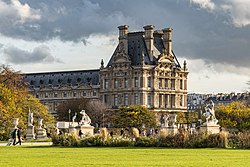| תיאור | English: 4 of the Louvre Museum melophores (immortal persian guard) from the famous glazed bricks friezes found in the apadana (Darius the Great's palace) in Susa (Shush) by french archeologist Marcel Dieulafoy and brought in Paris. Such polychromic friezes used to decorate the Achaemenian king's palaces in their capitales of Shush, Ecbatan, and Persepolis. According to the ancient greek scholars, the royal troopers were 10000, any dead being straight away replaced explaining their name of immortals. Only persian and median nobles could access such function. They constitued sections of 1000 soldiers, armed with archs, shields, and lances, each section being commanded by officers named chyliarchs. According to Historian Pierre Briant who opposed the generally admitted idea derived from the greek historian's reports and despite their rich and colorful uniforms, these soldiers were neither a parade army nor some fastuous guard units, but elite fighters who were engaged in most of the empire’s military campaigns.
Pavillon Sully at the Louvre museum, Paris, France, March 2010
Français : 4 des mélophores (gardes perses immortels) des fameuses frises de céramique en briques cuites à glaçures trouvées dans le tell de l’Apadana (palais de Darius le Grand) à Suse (Shush) par l’archéologue français marcel Dieulafoy et ramenées à Paris. De telles frises polychromiques décoraient les façades des palais royaux achéménides dans leur capitales d’Ecbatane, Suse et Persépolis. Selon les écrits des anciens historiens grecs, les gardes royaux étaient au nombre de 1000, chaque mort était remplacé immédiatement d’où le nom d’immortel puisque leur nombre restait ainsi constant. Seuls, de jeunes nobles perses et mèdes pouvaient accéder à cette fonction. Ils étaient organisés en section de 1000 soldats, armés d’arcs, de boucliers et de lances, chaque section était commandée par un officier supérieur appelé un Chyliarque. Selon les ouvrages de l’historien Pierre Briant, qui s’oppose à l’idée généralement admise influencée par les écrits grecs anciens, et malgré la richesse colorée de leur tenue, il ne s’agit nullement d’une armée de parade ou d’unités de gardes de luxe, mais de combattants d’élite qui ont été engagés dans la plupart des campagnes militaires impériales.
Pavillon Sully, musée du Louvre, Paris, France, Mars 2010 |




 Français
Français Italiano
Italiano



